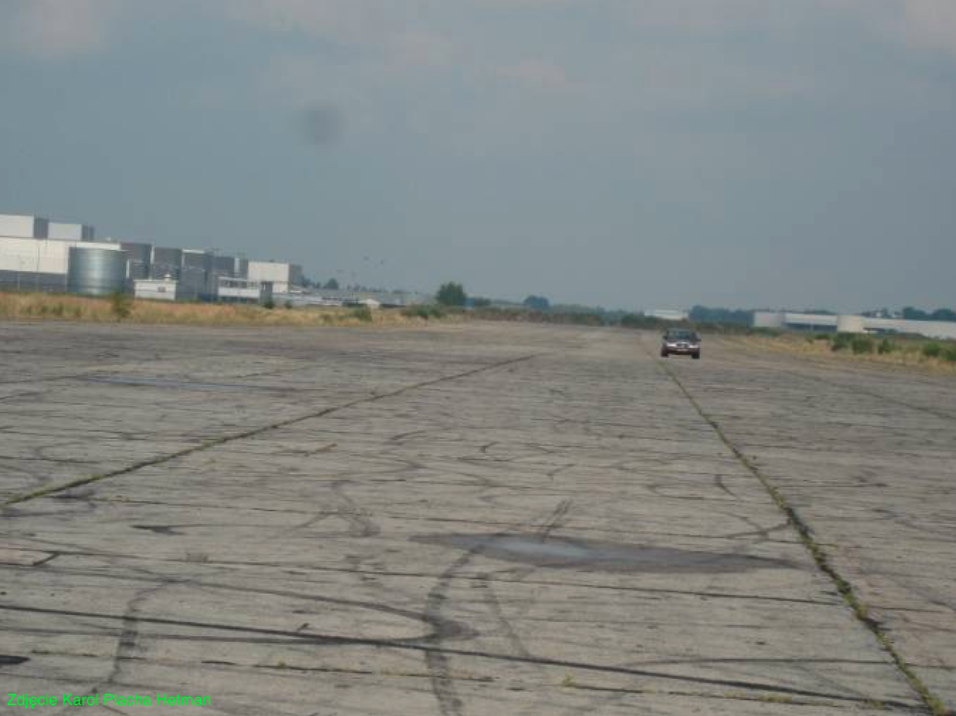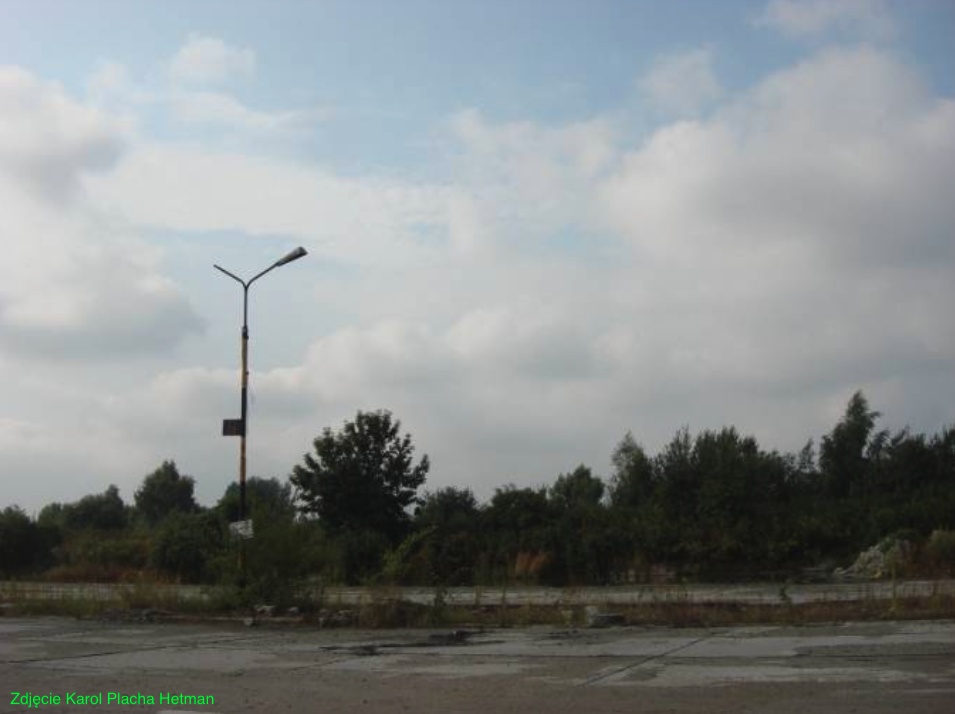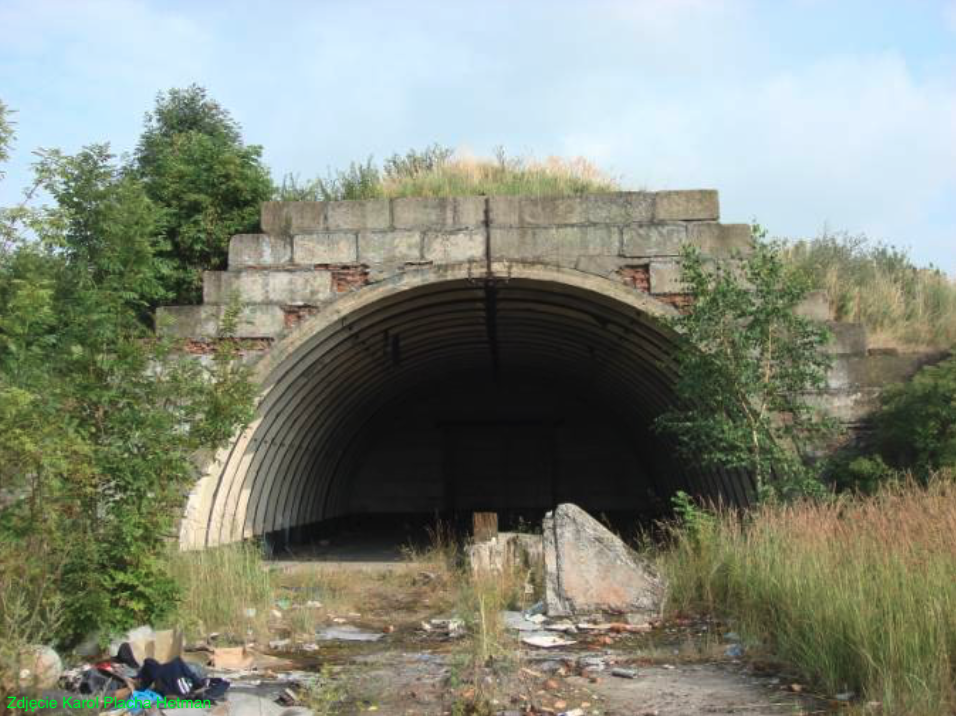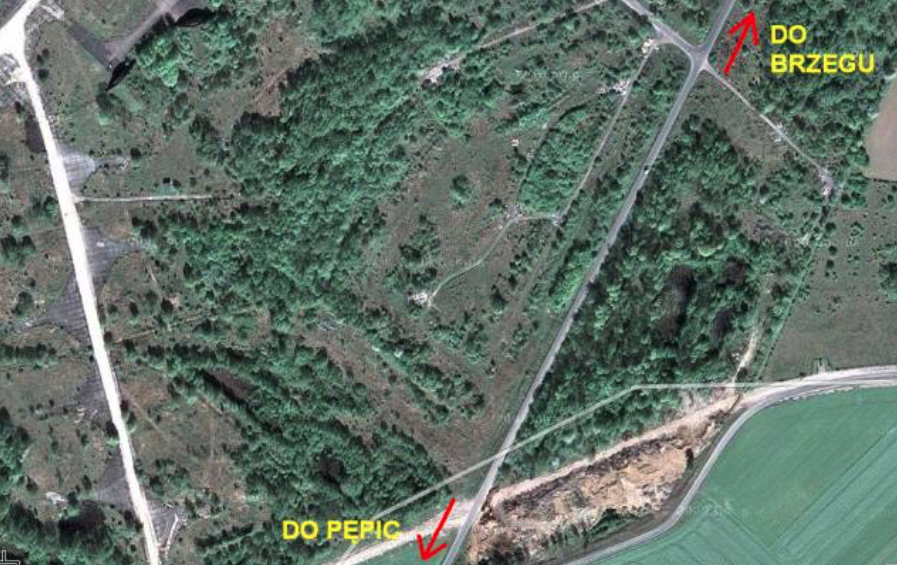Brzeg 2007-12-23
Former airport in Brzeg.
Geographic coordinates: 50.838N 17.409E. Elevation 151 m.


Photo description: Cadbury plants on the left, Keiper plants on the right.

Photo description: Southern plane parking area.


History of the City of Brzeg.
The city of Brzeg is located in Lower Silesia, halfway between Opole and Wrocław, at the intersection of land and water routes. Brzeg is one of the oldest towns in Lower Silesia. The first information about the settlement appeared in documents as early as 1234. The city was founded under western law between 1246 and 1248. The location was confirmed in 1250, in a document issued by Henry III, Duke of Wrocław, where the location area was designated. Already in the second half of the 13th century, orders settled in the city; Franciscans, Dominicans, Joannites. In 1311, the Duchy of Wrocław was divided into three smaller ones. Brzeg became the capital of one of them.
Brzeg experienced its greatest prosperity during the reign of the Piast line in the Duchy of Legnica-Brzeg. Prince Bolesław III was the first to unite the Duchy of Brzesko with Legnica in 1312. Both principalities separated and united several times. In 1329, Bolesław III became a Czech vassal, and in 1342, he made Brzeg his permanent residence. The next ruler, Louis I, became a patron of construction and cultural development. He expanded the prince's castle. Next door, he founded the collegiate church of St. Jadwiga, and in it he placed a rich collection of books. He also founded other churches. After the town hall burned down in 1380, he rebuilt it. In 1390, Louis I carried out the first recorded archaeological research in Poland.
But the town of Brzeg was also plagued by fires and the Hussites, who destroyed it in 1428-1432. The largest territorial scope of the Duchy of Brzeg extended to Lubin, Chojnów, Oława, Kluczbork, Byczyna, and Strzelin. From the mid-15th century, the area gradually decreased. The duchy and the city began to suffer from regression.
In the 16th century, during the rule of George I, Brzeg regained its lost status as the capital of the Duchy of Legnica-Brzeg. The Lutheran religion was introduced to the principality, which resulted in the exile of the Franciscan and Dominican Fathers. Frederick II, started the Renaissance reconstruction of the castle. Due to the threat of Turkish invasion, the prince decided to rebuild the city fortifications. During the fortification works, the oldest Romanesque church of the Blessed Virgin Mary known from sources was demolished. In 1545, the church and monastery of the Dominican Fathers were demolished. Construction work was continued by Prince George II. After 1582, the Franciscan church was rebuilt into an arsenal.
In the 16th century, Brzeg became a thriving trade center due to its location between the Republic of Poland and Germania. During the Thirty Years' War, Brzeg was not captured by the besieging Swedish troops. However, the war had a negative impact on the situation of the duchy and the city. In 1675, George IV William died - the last male representative of the Piast dynasty. The city and the duchy then became part of the Habsburg Monarchy. Habsburg rule brought with it attempts to restore Catholicism. In place of the orders removed in the 16th century, the Jesuit Fathers and the Capuchin Fathers were brought to Brzeg and built their monasteries and churches in Brzeg.
In 1741, Brzeg was severely damaged during the siege by the troops of the Prussian king Frederick II the Great, and in 1742, together with the entire Silesia, it came under Prussian rule. Brzeg became a district town with a military garrison. After the city was occupied by Napoleon's troops in 1807, the existing fortifications were ordered to be dismantled. In their place, promenades, parks and plantations were created. Already in 1842, a railway was connected to the city. In the mid-19th century, Brzeg became an urban center of local importance. This situation lasted until the 1970s. The turn of the 19th and 20th centuries was a time of expansion of the city. In 1907, Brzeg was excluded from the district and received a higher rank of a separate city.
Shortly after the end of World War II, the city again became a garrison town. This was facilitated by the airport established in 1916.
World War II unleashed by the Germanic army brought only destruction to the city that was immemorial in history and a change of statehood. The problem lay not in the change of nationality itself, but in the forcefully introduced communist power, with its main representatives in the form of CCCP citizens. The indigenous inhabitants of Brzeg were expelled. The end of World War II did not mean that the city ceased to be a garrison. On the contrary, the Soviets maintained significant military units in the city until 1993. At the same time, about 15,000 Soviet soldiers were stationed there. Reconstruction from war damage was accompanied by the expansion of industry, mainly food and electrical machinery. New residential districts were built in the developing southern part of the city. Until 1950, Brzeg was located in the Wrocław Voivodeship, and after the administration reform carried out at that time, it became part of the Opole Voivodeship.
During the celebration of the millennium of Poland's baptism, the so-called "Brest accidents" occurred in the city in May 1966. Despite the opposition of the residents, the Citizens' Militia removed the clergy from the parish house at Castle Square. The opposition of the city's inhabitants resulted in repression by the security service.
After the administrative reform in 1975, the Brzeg district was liquidated. In 1997, the northern part of the city suffered from floods that affected the south of Poland. Since January 1999, Brzeg is again the seat of the district.
The main railway line connecting Silesia with the port of Szczecin runs through the town of Brzeg.
History of Brzeg Airport.
Germanic period.
The Brzeg airport was located south-west of the town of Brzeg, in the fields of Skarbimierz, Pępice and Małujowice. We write it was because the history of this airport is now closed and no plane will take off from this place anymore.
The airport was founded in 1916. Initially, it owed its name to the town of Skarbimierz, because it was built on its territory. Planes taking off from it took part in the fighting of the Great World War.
After the end of the Great World War, as a result of the demilitarization of Germany-Prussia, the airport was forgotten. Only after Hitler came to power (1933) did the expansion of the airport begin. At first secretly, and then openly. The airport began to be adapted to the needs of German aviation. The flight field was still grassy. The Germans treated it as a field airport for units stationed near Wrocław. During this period, the name of the airport began to appear - Pępice (Pampitz).
In September 1939, bomber planes took off from the Brzeg airport to launch raids on the Republic of Poland. The military victory of the Germanic army over the Republic of Poland resulted in the expansion of the airport. The Germans appreciated the strategic location of the facility and gradually the airport turned from a field airport into a permanent air base in the south-east. Additional arguments were the rich road and railway network between Wrocław and Upper Silesia.
The success in the September campaign brought thousands of Polish prisoners of war to the German army, some of whom they decided to use for slave labor in the ever-expanding arms industry and development of military infrastructure. The German army also decided to involve prisoners from the September Campaign in the expansion of the military airport near Pępice. This is how the "Brieg-Pampitz" labor camp was created, established in October 1939, and existing until January 23, 1945, when, due to the Soviet front approaching from the east, the Germans left the camp and evacuated the prisoners towards the Sudetes. The camp was located in the south-eastern part of the military complex.

The prisoners in the camp worked mainly on the expansion of the military complex, but also in the town of Brzeg itself and on the roads. Already in the spring of 1940, the entire airport fortification system was built. Then the prisoners worked on the construction of new airport facilities, mainly roads.
There were prisoners of various nationalities in the camp. The first were Poles. In 1940, transports of prisoners from Western Europe began to arrive, mainly French and Belgians. There were also Muscovites. Just before liberation, German criminals began to be brought to the camp. Up to 5,000 people could stay in the camp at the same time, and a total of 25,000 people could pass through the camp. Most of the prisoners lost their lives there. In mid-1944, the POW camp became a concentration camp as a branch of the Germanic "Gross-Rosen" concentration camp. After the war, a commemorative plaque was installed at the place of execution.
The German army did not implement all plans to expand the airport. It was planned, among other things, to build three DS (RWY) intersecting each other, following the example of airport projects from the 1940s. The first one in the direction 09/27, the second one in the direction 05/23, the third one in the direction 12/30. The first one was implemented. The next two were partially completed and remained as taxiways. During World War II, it built a headquarters and barracks in the form of two large buildings in the northern part of the complex. Renovation hangars for aircraft were also built. Probably two. Also at this time, a railway siding was built to the airport.
Mieczysław Dukalski "Zapora".
In the Chapter we included the story of the daring escape from the camp of Major Mieczysław Dukalski, a soldier of the Home Army and the National Armed Forces. Although the website is aviation, we cannot ignore the history of our compatriots who shed their blood for the Independent Republic of Poland.
In August 1944, Warsaw insurgents captured in Warsaw and imprisoned at Pawiak were brought to the camp. At that time, there were about one thousand Polish prisoners in the camp, including 600 soldiers of the Home Army. This group included a dozen or so soldiers of the Warsaw Special Action, a militia of the National Armed Forces, headed by Captain Mieczysław Dukalski, who used the pseudonym "Zapora". "Zapora" was arrested by the Gestapo on July 23, 1944, in a Warsaw tram. On August 7, 1944, he and his comrades found themselves in the "Gross-Rosen" concentration camp, from where, after a few days' stay, they were transported to the "Brieg-Pempitz" labor camp, on the southern edge of the Brzeg airport.
The Poles included mainly Home Army soldiers, but also fighters from the BCh and NSZ. Among them were 15 officers and 30 non-commissioned officers. A camp conspiracy was formed, headed by Captain Pleban of the Home Army and Captain Dukalski of the NSZ, as his deputy. The conspirators organized themselves along military lines, creating a cadre battalion which was to take over the camp when the front collapsed and the resulting panic among the guards, as the prisoners were counting on. Officers and non-commissioned officers were planned to command 4 companies, and the best staffed was the assault platoon, consisting only of people from the NSZ Special Action. Life inside the camp was completely dominated by the secret structures of the battalion, positively affecting the morale of the prisoners and serving as a warning to the guards, mostly Silesians, who, taking this potential into account, treated the prisoners correctly.
This state of affairs was interrupted at the beginning of October 1944, when a group of over 500 prisoners, mainly Russians, arrived at the camp, and a large group of Poles were taken away. In this way, the battalion's structures were destroyed and the face of the camp conspiracy was changed. In this situation, a group of prisoners led by Capt. Dukalski, decided to escape from the camp on her own. A tunnel was chosen as the escape route. The work went on day and night. Meanwhile, the structure of the camp was changing more and more to the detriment of the conspirators. German criminal prisoners began to arrive at the camp, replacing Polish prisoners who were being taken as far away from the approaching front as possible. The group gathered around Capt. Dukalski and Capt. The parsonage, constituting the remnants of the cadre battalion, decided to act immediately, before they themselves were deported somewhere deep into the Third Reich. An opportunity arose when, at the beginning of December 1944, workers began to form commandos to work outside the camp, unloading railway wagons at the Lewin Brzeski station. A new escape plan was developed. At the end of the work, disarming the guards and escaping in a truck to the border of the General Governorate. In total, the escape group consisted of 30 people who formed a platoon, including Capt. Pleban, as commander, Capt. Dukalski, deputy commander and guide Lt. Ostrzyński, the rest were privates, over half of whom came from the NSZ. However, the matter came to light. On the day of the escape, January 5, 1944, the guards prevented the formation of a commando of those willing to escape. Even bribed guards divided Captain Dukalski's team, which received 10 new unknown people. Undeterred by adversity, Capt. However, Dukalski decided to escape, because even the bribed guards decided to confront him after returning from work. Once again, the guards were drunk with transported alcohol. Almost at the beginning of their work, the guards were lured into a truck with cognac and the surprised guards were quickly disarmed. One of the guards escaped and the truck could not go faster than 40 km/h. Luckily, they passed through Opole and found the road to Częstochowa. After another hour of driving, they noticed German trucks in front of and behind them. Feeling it was an ambush, they slowed down. The Germans did the same. The fugitives ran into the forest. They marched forcefully towards the border. They encountered an ambush in which 8 escapees died. Only 9 of them remained, and they again took refuge deep in the forest. They had a pistol and four rifles at their disposal. Dukalski organized the group on a partisan model. They marched at night, covering 20 km. While sleeping during the day, they appointed successive guards, and during frosts they exchanged coats, of which they had only a few. In this way, the group marched for 7 consecutive days.
Unfortunately, the next night they were ambushed by SS men commanded by a major. Resistance meant death. The unit surrendered. They were transported to Opole. The escape left a huge impression. The Germans couldn't believe that on their own territory, such a large group would dare to organize an escape, disarming the soldiers, and then continue their journey in broad daylight in their own military car and in German uniforms. If it weren't for an unfortunate shooting on the road with the gendarmerie, the escapees would have successfully reached the country on the same day. As it turned out, until that moment the Germans had no idea of the situation, and all signals, such as the escape of the guard or passing through the checkpoint in Opole, were ignored. Even encountering a car with gendarmes on the road near Ozimek was completely accidental, and the "suspiciously" slow driving of the gendarmes was caused by the fact that they were taking a driving course. Unbelievable for the Germans, the feat of Dukalski and his team became so famous that it reached the very Berlin, who issued instructions to immediately send the entire, compromised staff of the "Brieg-Pampitz" camp to the Eastern Front. A death sentence was passed against Dukalski, for which the convict awaited execution in the "Gross-Rosen" concentration camp. However, the approaching end of the war, and with it the chaos and administrative confusion, meant that the sentence was postponed. Dukalski was transported to the camp in Litoměřice in in the Czech Republic. Here, however, the Berlin death sentence catches up with him - exactly a few weeks before the end of the war. Dukalski, however, was once again very lucky. Polish doctors staying in Litomierzyce faked the captain's death. They took advantage of the Germans' fear of typhus and the fact that the torturers practically went to the sick barracks. they did not enter. Dukalski, who was infected with typhus, was registered as dead and released under the number of another prisoner who did not survive the disease. His escape finally had a happy ending. He joined the Świętokrzyska Brigade of the National Armed Forces under the command of Americans. After the war, he emigrated to French Guiana in South America, and in the 1980s to France, where he became actively involved in the life of Polish veteran communities. Until the end of his life, he was a Pole, a Patriot, recognizing the communists as the next oppressors of Poland. He did not accept the award of the National Cross of Armed Action only because it was awarded by Aleksander Kwaśniewski (a communist). Major Mieczysław Dukalski "Zapora" (promoted to the rank of major before his death) died in 1998 in Paris.
Soviet period. Aviation units.
On January 23, 1945, the airport was occupied by Soviet troops. The speed of the eastern front was so great that the Germanic troops were surprised. They did not have time to withdraw because they counted on the German state remaining within the borders before World War II. A large amount of equipment and ammunition fell into the hands of the Soviets. The Soviets treated the Brzeg airport as a spoil of war. Just like a dozen or so others located in the so-called recovered territories. The airport was systematically adapted to the needs of the CCCP's imperial plans.
In the period from 1945 to 1993, several aviation units were stationed at the Brzeg airport at various times, of which the reconnaissance ones always came to the fore.
159th Fighter Aviation Regiment. - He was stationed in Brzeg in the 1940s and 1950s. The regiment used Yak-15, Yak-17, Yak-23 and MiG-9 fighters. We must also include training versions of these planes. The large number of types made operation difficult. This includes pilot training, inspections and repairs. However, this first period of operation of turbojet-powered aircraft allowed for valuable aviation experience.
Poles at the Brzeg airport. – In July 1950, the Polish Air Force Command sent a group of 4 pilots to train on the new type of Yak-17 aircraft; Lt. Col. (Capt.) Wasyl Gaszyn (Soviet advisor from the Air Force Command), Lt. Col. Aleksander Markow (Soviet advisor from the Aviation Officers' School in Dęblin), Capt. Andrzej Rybacki from the 1st PLM, Lt. Kazimierz Tanana from the 2nd PLM. The pilots were sent to the Brzeg airport. The training was quick. Capt. Pilot Andrzej Rybacki and Lt. Pilot Kazimierz Tanana made their first independent flights in the first days of August 1950, and by the end of the course each of them had flown 6 hours on turbojet aircraft.
In 1951, further pilots from the 1st PLM were trained in turbojet-powered aircraft; captain Wiącek, Capt. Bajczykow, captain Krepski, Capt. Paniewski, second lieutenant Iwoń and second lieutenant Smolnik, and next: 2nd Lieutenant. Dobrzeniecki, second lieutenant Płoszański, second lieutenant Władysław Hermaszewski and others. They also completed a significant part of the training at the Brzeg airport.
In the 1950s and 1960s, at least three air regiments were stationed at the airport. Unfortunately, I don't know their numbers. These were hunting and reconnaissance units. They were equipped with MiG-15, MiG-17 and MiG-21 aircraft. The first two types performed photographic reconnaissance (also in infrared). The MiG-21 R was also capable of radio reconnaissance.
151st Independent Electronic Warfare Regiment. - The regiment arrived in Brzeg at the turn of the 1960s and 1970s. It was equipped with Yak-28 PP aircraft, intended to destroy enemy radar stations. These planes were fighter-bomber in nature and had supersonic speeds. The regiment was withdrawn from Polish territory at the end of the 1980s.
164th Kerch Reconnaissance Aviation Regiment (Kerch Independent Reconnaissance Aviation Regiment) - equipped with the following aircraft: MiG-25 RB, MiG-25 BM, Su-24 MR. It was stationed at the airport from December 31, 1958 to August 1, 1990. The regiment was formed on August 25, 1941. He fought in Iran, and after its capture, the regiment was transferred to the German-Soviet front in Europe at the end of 1941. Major Soboljev's plane was shot down in its first flight. Then the regiment lost two more planes. In the period from December 1941 to August 1942, the unit participated in fighting in Donbas. Then in the fighting in the Caucasus. In 1942, SB-2 aircraft replaced the Pe-2. In the period 1942–1943, the unit was stationed in Grozny. The crews carried out reconnaissance flights against Germanic troops retreating from the Caucasus. Then the regiment was moved to other airfields. The regiment also received American-made aircraft. As part of the 4th Air Army, the Regiment participated in the Belarusian operation. In August 1944, the planes landed at the airport in Białystok. The regiment was stationed here until January 31, 1945. The regiment then participated in battles in Pomerania, including the battles for Gdynia, Gdańsk, Central and Western Pomerania. Ultimately, the unit landed at the German airport Rotzow, and then it was moved to Tutow, and from there to Toruń. In total, during the war, the regiment destroyed 45 enemy aircraft, about 280 tanks and armored vehicles, and 3,000 cars. Own losses: 55 aircraft. On December 31, 1947, the regiment was transferred to Brzeg. He was stationed there until November 30, 1952. Then he was stationed at the airport in Krzywa, near Legnica. In 1954, the Pe-2 aircraft were replaced by the Yak-25 R. Also in the training version. On December 31, 1958, the regiment was again based at the Brzeg airport, where it was stationed until 1990. In 1961, the regiment was equipped with Yak-27 R aircraft.
Poles once again in Brzeg. – Due to the planned purchase of Jak-27 R aircraft by the Polish Military Aviation in 1961, the first group of Polish pilots was trained. The training was not completed because the Polish Ministry of National Defense assessed that the combat value of the Yak-27 R was slightly higher than that of the Il-28 R aircraft used in Poland.
From 1967, the aircraft was also equipped with Yak-28 R planes. The first Soviet reconnaissance planes with supersonic speed. They were supplemented by the Yak-28 U training and combat aircraft. In 1973, the Yak-27 R and Il-28 R machines began to be withdrawn. They were replaced by MiG-25 RB and Yak-28 PP aircraft intended for electronic warfare. Since 1973, MiG-25 RBSs and MiG-25 RBSns were stationed in Brzeg. Reconnaissance planes with a radar side station. Two copies each. In 1978, MiG-25 RBTS planes also appeared. They had the ability to carry an additional fuel tank and, above all, carried nuclear weapons. There were usually 5 nuclear strike planes in stock. They were supplemented by MiG-25 RU training and combat vehicles, of which there were usually 3 copies in stock. At the beginning of the 1980s, the Yak-28 PP was replaced by MiG-25 BM aircraft.
From 1985, the Yak-28 R aircraft were replaced with reconnaissance Su-24 MR (reconnaissance version of the Su-24 M bomber). Until 1990, the regiment consisted of 3 squadrons: 1st operational reconnaissance squadron MiG-25 RB, 2nd tactical reconnaissance squadron Su-24 MR, 3rd air defense breaching squadron MiG-25 BM.
In August 1990, the regiment was moved again to the airport in Krzywa. The air defense breach squadron departed for CCCP. The last commander was colonel. Viktor Ponomarev. The regiment was stationed in Poland until May 14, 1992, and then it flew to the air base in Szatałów in CCCP.
55th Sevastopol Independent Helicopter Regiment - from April 1981 to June 1989, when the unit was moved to the Legnica airport and then to the Bagicz airport.
871 Pomeranian Fighter Aviation Regiment - transferred in 1989, from Bagicz airport. He was stationed at the Brzeg airport until 1990.
Information about the regiments and their planes should be supplemented with the numerous transport planes arriving in Brzeg. Without a doubt, the main means of transport was the railway. But much of the transportation, such as weapons and ammunition, was by air. The planes that arrived in Brzeg included (according to the timeline); Li-2, Il-12, Il-14, Il-18, An-12, An-24, An-26, An-32, Il-76. Among these machines, we will mention the An-12 and Il-76 as long-lived ones. Certainly, during the attack of the communist bloc (UW) on Czechoslovakia (1968), An-12 transport aircraft took off and landed from the Brzeg airport dozens of times.
Written by Karol Placha Hetman
